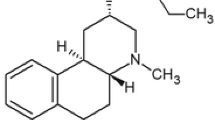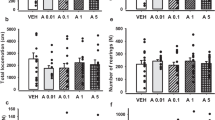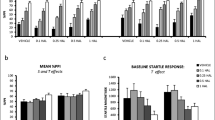Abstract
The effects of pretreatments on behavioural responses to activation of 5-HT1C receptors bym-chlorophenylpiperazine (mCPP) were investigated. The hypo locomotor and anxiogenic effects ofmCPP (social interaction test) were influenced neither by previous housing (single versus grouped) nor by restraint (2 h, 24 h previously). In the absence ofmCPP, 24 h group housing led to decreased social interaction and the restraint procedure led to significant decreases of feeding and locomotion. The hypophagic effect ofmCPP was unaffected by previous restraint. However, chronic pretreatment withmCPP (2.5 mg/kg per day IP × 14) or with the antidepressant 5-HT reuptake inhibitor sertraline (5 mg/kg per day SC × 14) attenuated all three behaviours. The above findings are discussed with respect to published data on effects of pretreatments on responses to the activation of 5-HT1C receptors.
Similar content being viewed by others
References
Aulakh CS, Hill JL, Tolliver TJ, Marcantonio D, Murphy DL (1991) Long term administration ofm-chlorophenylpiperazine to rats does not alter functional sensitivity of either presynaptic or postsynaptic 5-HT1A receptors. J Psychopharmacol 5:142–148
Benjamin D, Saiff EI, Nevins T, Lal H (1992) Mianserin-induced 5-HT2 receptor downregulation results in anxiolytic effects in the elevated plus-maze test. Drug Dev Res 26:287–297
Berendsen HHG, Broekkamp CLE (1991) Attenuation of 5-HT1A and 5-HT2 but not 5-HT1C receptor mediated behaviour in rats following chronic treatment with 5-HT receptor agonists, antagonists or anti-depressant. Psychopharmacology 105:219–224
Cadogan AK, Wright IK, Coombs I, Marsden CA, Kendall DA, Tulloch I (1992) Repeated paroxetine administration in the rat produces an anxiolytic profile in the elevated X-maze and a decreased3H-ketanserin binding. Neurosci Lett Suppl 42:S8
Conn JE, Sanders-Bush E (1987) Central serotonin receptors: effector systems, physiological roles and regulation. Psychopharmacology 92:267–277
Curzon G, Kennett GA (1990)mCPP: a tool for studying behavioural responses associated with 5-HT1C receptors. TIPS 11:181–182
Freo U, Holloway HW, Greig NH, Soncrant TT (1992) Chronic treatment with metachlorophenylpiperazine (m-CPP) alters behavioural and cerebral metabolic responses to the serotonin agonistsm-CPP and quipazine but not 8-hydroxy-2 (di-N-propylamino) tetralin. Psychopharmacology 107:30–38
Gibson EL, Barnfield AMC, Curzon G (1992)mCPP-induced anxiety in the elevated plus-maze: post-synaptic 5-HT mediation. J Psychopharmacol Abstr A52
Hoffman BJ, Mezey E (1989) Distribution of serotonin 5-HT1C receptormRNA in adult rat brain. FEBS Lett 247:453–462
Hollander E, De Caria C, Gully R, Nitescu A, Suckow RF, Gorman JM, Klein DF, Liebowitz MR (1991) Effects of chronic fluoxetine treatment on behavioural and neuroendocrine responses to metachlorophenylpiperazine. Psychiatry Res 36:1–17
Hoyer D (1988) Functional correlates of serotonin 5-HT1 recognition sites. J Recept Res 8:59–81
Hoyer D (1991) The 5-HT receptor family: ligands, distribution and receptor effector coupling In: Rodgers RA, Cooper SJ (eds) 5-HT1A agonists, 5-HT3 antagonists and benzodiazepines: their comparative behavioural pharmacology. Wiley, New York, pp 31–57
Hutson PH, Donohoe TP, Curzon G (1988) Infusion of the 5-hydroxytryptamine agonists RU 24969 and TFMPP into the paraventricular nucleus of the hypothalamus causes hypophagia. Psychopharmacology 95:550–552
Kennett GA (1992) 5-HT1C receptor antagonists have anxiolytic-like actions in the rat social interaction model. Psychopharmacology 107:379–384
Kennett GA, Curzon G (1988a) Evidence thatmCPP may have behavioural effects mediated by central 5-HT1C receptors. Br J Pharmacol 94:137–147
Kennett GA, Curzon G (1988b) Evidence that hypophagia induced bymCPP and TFMPP requires 5-HT1C and 5-HT1B receptors; hypophagia induced by RU 24969 requires 5-HT1B receptors. Psychopharmacology 96:93–100
Kennett GA, Curzon G (1991) Potencies of antagonists indicate that 5-HT1C receptors mediate 1-3(chlorophenyl)piperazine-induced hypophagia. Br J Pharmacol 103:2016–2020
Kennett GA, Whitton P, Shah K, Curzon G (1989) Anxiogenic-like effects ofmCPP and TFMPP in animal models are opposed by 5-HT1C receptor antagonists. Eur J Pharmacol 164:445–454
Lightowler S, Williamson IJR, Hegarty S, Kennett GA, Fears RB, Tulloch IF (1992) Anxiolytic effect of paroxetine in the rat social interaction model of anxiety. Br J Pharmacol 106:44P
Maj J, Moryl E (1992) Effects of sertraline and citalopram given repeatedly on the responsiveness of 5-HT receptor subpopulations. J Neural Transm 88:143–156
Mendels J (1987) Clinical experience with serotonin reuptake inhibiting antidepressants. J Clin Psychiatry 48 [Suppl 3]:26–30
Moreau JL, Jenck F, Martin JR, Perrin S, Haefely WE (1992) Modulation of 5-HT1C receptor-mediated effects by chronic mild stress or antidepressant therapy in rats. J Psychopharmacol Abstracts A13
Murphy DL, Lesch KP, Aulakh CS, Pigott TA (1991) Serotonin-selective arylpiperazines with neuroendocrine, behavioural, temperature and cardiovascular effects in humans. Pharmacol Revs 43:527–552
Nutt DJ (1990) The pharmacology of human anxiety. Pharmacol Ther 47:233–266
Pazos A, Probst A, Palacios JM (1987) Serotonin receptors in the human brain-III Autoradiographic mapping of serotonin-I receptors. Neuroscience 21:97–122
Pranzatelli MR (1991) Regulation of 5-HT2 receptors in rat cortex. Studies with a putative selective agonist and an antagonist. Biochem Pharmacol 42:1099–1105
Pranzatelli MR, Murthy JN (1991) Novel regulation of 5-HT1C receptors. Abstr Soc Neurosci 17:287.9
Roth BL, Hamblin M, Ciaranello RD (1990) Regulation of 5-HT2 and 5-HT1C serotonin receptor levels. Methodology and mechanisms. Neuropsychopharmacology 3:427–433
Samanin R, Mennini T, Ferraris A, Bendotti C, Borsini F, Garattini S (1979)m-Chlorophenylpiperazine: a central serotonin agonist causing powerful anorexia in rats. Naunyn-Schmiedeberg's Arch Pharmacol 308:159–163
Sanders-Bush E (1990) Adaptive regulation of central serotonin receptors linked to phosphoinositide hydrolysis. Neuropsychopharmacology 3:411–416
Sanders-Bush E, Breeding M, Knoth K, Tsutsumi M (1989) Sertr aline-induced desensitization of the serotonin 5-HT2 receptor transmembrane signaling system. Psychopharmacology 99:64–69
Schmidt AW, Peroutka SJ (1989) 5-Hydroxytryptamine receptor “families.” FASEB J 3:2241–2249
Sharma A, Fone KCF (1992) 5-HT agonist regulation of 5-HT1C receptors. Br J Pharmacol 107:7P
Sills MA, Lucki I, Frazer A (1985) Development of selective tolerance to the serotonin behavioural syndrome and suppression of locomotor activity after repeated administration of either 5-MeODMT ormCPP. Life Sci 36:2463–2469
Suckow RF, Cooper TB, Kahn RS (1990) High performance liquid chromatographic method for the analysis of plasmam-chlorophenylpiperazine. J Chromatogr 528:228–234
Ulrichsen J, Partilla JS, Dax EM (1992) Long-term administration ofm-chlorophenylpiperazine (mCPP) to rats induces changes in serotonin receptor binding, dopamine levels and locomotor activity without altering prolactin and corticosterone secretion. Psychopharmacology 107:229–235
Whitton P, Curzon G (1990) Anxiogenic-like effect of infusing 1-(3-chlorophenyl)piperazine (mCPP) into the hippocampus. Psychopharmacology 100:138–140
Zohar J, Insel TR, Zohar-Kadouch RC, Hill JL, Murphy DL (1988) Serotonergic responsivity in obsessive-compulsive disorders: effects of chronic clomipramine treatment. Arch Gen Psychiatry 45:167–172
Author information
Authors and Affiliations
Rights and permissions
About this article
Cite this article
Kennedy, A.J., Gibson, E.L., O'Connell, M.T. et al. Effects of housing, restraint and chronic treatments withmCPP and sertraline on behavioural responses tomCPP. Psychopharmacology 113, 262–268 (1993). https://doi.org/10.1007/BF02245708
Received:
Revised:
Issue Date:
DOI: https://doi.org/10.1007/BF02245708




